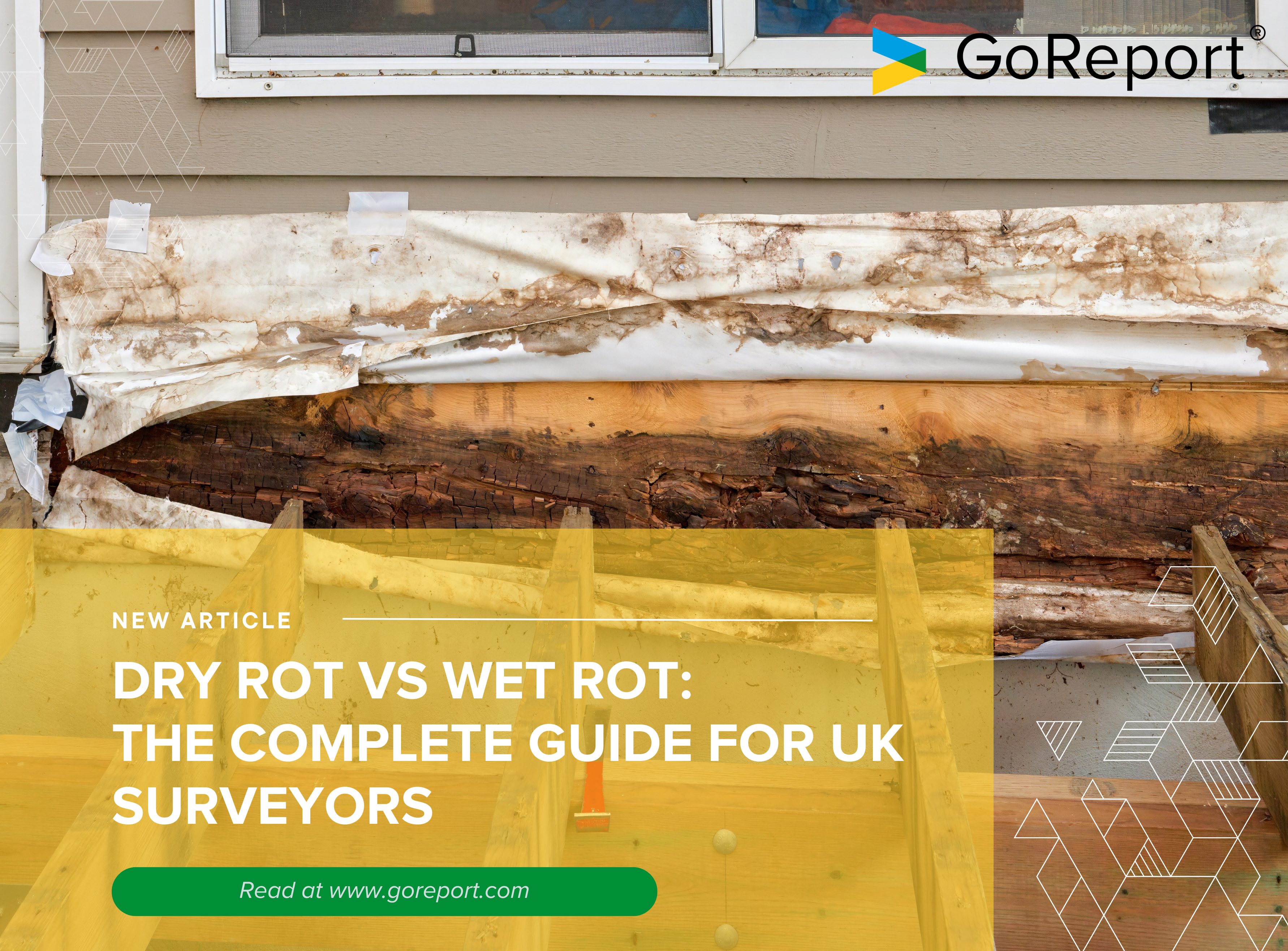Dry Rot vs Wet Rot: Guide for UK Surveyors

When surveying residential or commercial properties, spotting signs of timber decay is one of the key elements of a thorough inspection. Two of the most common culprits are dry rot and wet rot — but despite their similarities, the treatment methods, urgency, and overall impact on a building can be very different. That’s why understanding the nuances of dry rot vs wet rot is essential for any UK-based surveyor.
In this guide, we’ll cover everything from what dry rot is and what causes it, to what dry rot looks like, how to distinguish it from wet rot, and the best ways to treat and prevent both. Whether you’re conducting a routine damp survey, a homebuyer report, or a detailed structural investigation, this article will help you diagnose and report timber decay with confidence.
Contents:
- What is Dry Rot?
- What Causes Dry Rot?
- What Does Wet Rot Look Like?
- What is Wet Rot?
- What Causes Wet Rot?
- What Does Wet Rot Look Like?
- Dry Rot vs Wet Rot: What’s the Difference?
- Why Surveyors Need to Know the Difference
- How to Treat Dry Rot
- How to Treat Wet Rot
- Prevention Tips for Dry and Wet Rot
- FAQ: Dry Rot & Wet Rot
What Is Dry Rot
Dry rot is a type of fungal timber decay caused by Serpula lacrymans. Despite the name, dry rot still needs moisture to get started — usually a moisture content above 20% — but it can spread aggressively even after the source of moisture is removed. It’s considered the most serious form of timber decay because of its ability to travel through masonry and destroy structural wood in buildings. Compared to wet rot, dry rot spreads faster and is much more destructive.
What Causes Dry Rot?
The main cause of dry rot is excess moisture in timber. This can be due to:
- Leaking roofs or gutters
- Faulty plumbing
- Poor ventilation in subfloors or roof voids
- Rising damp
- Condensation in basements or poorly insulated areas
When moisture levels stay high enough, they create the perfect breeding ground for dry rot spores to germinate and grow. Once established, dry rot can spread rapidly and continue damaging timber, even if the moisture problem is fixed.
What Does Dry Rot Look Like?
One of the most common questions is: what does dry rot look like? Unfortunately, dry rot isn’t always obvious at first. In the early stages, you may see:
- A cotton wool-like mycelium on timber or masonry
- Rusty red dust (spores) near affected areas
- Shrinkage or warping in timber
- Cuboidal cracking (the timber breaks into cube-like pieces)
In more advanced stages, fruiting bodies can appear — often orange or brown with a soft, fleshy texture and white edges. These are the fungus trying to spread spores to new areas.
What Causes Wet Rot?
Wet rot typically occurs when timber is in prolonged contact with a moisture source. Causes include:
- Leaking pipes or tanks
- Overflowing gutters
- Penetrating damp from external walls
- Poorly maintained window frames
Wet rot is less aggressive than dry rot but still poses a significant risk to structural timber if left untreated. Unlike dry rot, it won’t migrate through masonry, but it will persist as long as moisture is present.
What Does Wet Rot Look Like?
Surveyors should look for the following signs:
- Timber that’s darker than surrounding wood
- A soft, spongy feel to the touch
- Cracking or flaking paint on timber
- Localised fungal growth
- A damp, musty smell
Unlike dry rot, wet rot doesn’t typically produce mycelium or fruiting bodies, and the damage usually stays close to the moisture source. Again, this highlights why identifying dry rot vs wet rot early is so vital.
Dry Rot vs Wet Rot: What’s the Difference?
While both dry rot and wet rot are caused by fungi, they behave quite differently. Understanding the key differences in dry rot vs wet rot will help you make the right call when writing up your reports.
Dry Rot:
- Caused by Serpula lacrymans
- Spreads rapidly, even through masonry
- Requires moisture to start, but not to continue
- Affects large areas
- Produces mycelium and fruiting bodies
Wet Rot:
- Caused by various fungi (commonly Coniophora puteana)
- Remains confined to areas where timber stays damp
- Doesn’t spread through masonry
- Localised damage only
- Wood feels spongy or soft when touched
The distinction between dry rot vs wet rot is essential knowledge for surveyors, as each has very different implications for remedial work and structural safety.
Why Surveyors Need to Know the Difference
From an inspection point of view, identifying whether you’re dealing with dry rot or wet rot is crucial. Misidentifying them can lead to:
- Incomplete or incorrect remediation work
- Ongoing damage to the building structure
- Unhappy clients
- Insurance claim issues
Correct diagnosis helps in creating an accurate report, recommending the right contractors, and ultimately protecting your client’s investment. Being clear on dry rot vs wet rot allows surveyors to produce reliable, actionable reports — and saves time, money, and hassle.
How to Treat Dry Rot
While you may not be treating the dry rot directly, it’s important to know the steps so you can outline the appropriate steps in your report. Treating dry rot involves a few clear steps:
- Identify and eliminate the source of moisture
- Remove all affected timber
- Apply specialist fungicidal treatments to surrounding areas
- Replace with pre-treated or appropriately durable timber
- Improve ventilation to prevent recurrence
Because dry rot can spread through masonry, it may be necessary to open up surrounding areas to check how far the fungus has travelled. Compared to wet rot, dry rot remediation tends to be more invasive and costly.
How to Treat Wet Rot
Wet rot treatment is typically more straightforward:
- Fix the moisture issue — no moisture, no rot
- Remove and replace damaged timber
- Improve ventilation or insulation as needed
Wet rot doesn’t spread beyond wet areas, so containment is usually easier. Still, identifying the issue early remains key. Again, understanding the differences in dry rot vs wet rot is critical here.
Prevention Tips for Dry and Wet Rot
As a surveyor, you’re in a great position to advise property owners on prevention. Here are a few key tips:
- Ensure good ventilation in all voids
- Fix leaks promptly
- Use treated timber in vulnerable areas
- Regularly inspect high-risk areas like basements, bathrooms, and lofts
- Keep exterior paintwork and sealants well maintained
Whether it’s dry rot or wet rot, prevention is almost always more affordable than treatment.
Whether you’re carrying out a pre-purchase inspection, a damp and timber survey, or general property assessment, understanding what dry rot is — and how it compares to wet rot — is essential for surveyors in the UK. Being able to confidently identify the signs, pinpoint the causes, and recommend the correct course of action helps protect both buildings and reputations.
Recognising the subtle but important differences between dry rot vs wet rot is a skill every modern surveyor should have. Armed with this guide, you can diagnose with confidence, advise with accuracy, and add more value to every inspection.
Want to make your surveys faster, clearer, and more compliant? GoReport supports surveyors across the UK with smart inspection software that makes reporting simple and professional. Start your free trial now – no credit card or commitment required.
FAQ: Dry Rot & Wet Rot
Is dry rot worse than wet rot? Yes — dry rot spreads faster and can affect more of the building structure, including masonry. Wet rot usually stays localised to damp areas.
Can dry rot come back after treatment? Yes, if the root cause (usually moisture) isn’t resolved. Treating the fungus without fixing the source of damp won’t prevent regrowth.
Do I need to replace all wood with dry rot? Generally, yes. All visibly affected timber should be removed and replaced with treated timber.
Is dry rot covered by insurance? Sometimes. It depends on your client’s policy and whether the cause was sudden or due to neglect.
Can dry rot spread to other properties? Not usually — unless there’s a shared wall or moisture path. But it’s always best to assess the surrounding risk.
What happens if dry rot is left untreated? Serious structural damage. It can compromise floors, joists, beams, and even spread through walls if not caught in time.
Looking to simplify reporting timber decay findings? GoReport offers surveyors powerful digital reporting tools to streamline inspections, identify issues like dry rot vs wet rot with clarity, and deliver professional reports with ease. Explore GoReport’s timber decay survey templates today.
Whether you’re carrying out a pre-purchase inspection, a damp and timber survey, or general property assessment, understanding what dry rot is — and how it compares to wet rot — is essential for surveyors in the UK. Being able to confidently identify the signs, pinpoint the causes, and recommend the correct course of action helps protect both buildings and reputations.
Recognising the subtle but important differences between dry rot vs wet rot is a skill every modern surveyor should have. Armed with this guide, you can diagnose with confidence, advise with accuracy, and add more value to every inspection.







